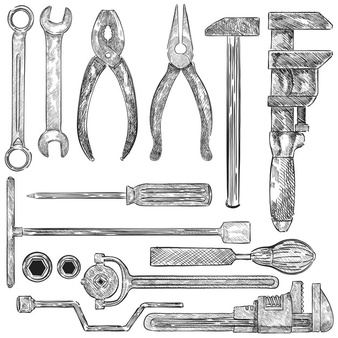Tools For Leaders

Leaders Start Fresh Every Day
I always have mixed feelings at New Year’s. On the one hand, there’s an unmistakable feeling of possibility, hope, fresh starts, and so on. On the other hand, if the past is any predictor of the future, there’s the unsettling memory of the historical reality from previous years, in that we don’t really change a whole lot. Inertia can be an awesome force.
But, if you’re in a leadership role in your organization, and aspire to make significant progress in a new year, I have an opportunity for you. It’s accompanied by the following request though: please don’t make any resolutions. If you feel the opportunity might be beneficial for your organization, I would ask you simply to take some action today, no matter how basic or small it may seem. Take action on just one thing. Resist the temptation to undertake too much (not that we’ve ever done that before). Do something, anything on just one action step – but make it irrevocable; something that will force continued forward movement in the process of change (like going over the spikes in the rental car return place). Force an accountability chain for yourself.
Remember: take just one action step.
Here it is, from Peter Drucker’s conversation on the Basic Functions of a Supervisor (meaning anyone who is in a role that requires working with and through other people in order to achieve results). We’ll talk about just one of those basic functions today, and mix in the others in future posts.
Create a better hiring process.
If you want to take some of the sting out of employee issues, you can’t operate much further upstream than the point of hire. If you don’t have a consistent, clear, methodical process, consider creating one. If your managers can’t quickly write down your company’s process in simple, easily understood terms, then it probably isn’t clear enough. It doesn’t have to be elaborate,but it should be structured so that the process purges the candidates, leaving a reasonably obvious final choice. You’ll never have as much leverage with an employee as you do at ‘The point of Hire’ – unfortunately, very few organizations use the moment wisely.
Everything is easier to get into than to get out of – it’s a whole lot easier to hire someone than to extricate yourself from a dysfunctional employee relationship. Slow the process down. And no same day, single interview hiring. Being too eager to hire leads to countless future problems with employees.
But even before the hiring process itself, we also want to focus more on effective recruitment. Recruit out of strength, not desperation. Recruit when you don’t need people. Make it a continuous, conscious process. Keep records. Follow up with people – in many ways, it’s exactly like a sales process!
Build a more structured interview process. Do more advance preparation. Don’t be over-or-under-impressed with the resume – the business of producing beautiful resumes has made them much less reliable as a selection tool. Nobody’s ever as good as they look or as bad as they look – either on the resume, or in the interview. Talk less. Remember, job candidates have been coached to keep you talking! Resist the temptation. Don’t share your entire autobiography or war stories – tragically, no one cares. Use multiple interviews and multiple interviewers. Make it hard to get in and easy to get out. Elevate your interviewing skills. Take notes. Don’t trust your initial perceptions; remember our senses are notoriously unreliable (we used to think the world was flat not that many years ago). The person who ends up coming to work often looks strangely different than the person you interviewed. You want to assemble multiple data points – the resume, fact-checking, online research, some type of personality assessment, assorted interviews, etc. Create a framework of the knowledge, skills, and attributes the job requires first, then compare the data points of the candidates to that.
Avoid trite questions (“tell me a little about yourself”). Ask questions that require thought. You’re looking for patterns over time. Patterns will be repeated. Patterns are the gateway to the mind. If you need help with interview questions, send me an email; I’ve got a bunch.
Upgrade the selection process – beware hiring clones. Don’t over-value skill, knowledge, or experience. Don’t assume past success predicts future success. Hire character and “teachability” first. Don’t confuse personality with ability. Don’t think about self-preservation – we want to always hire up; that is we want to seek people who are better, faster, stronger, and smarter than we are. Do your homework! When you are ready to pull the trigger, stop. Breathe. Think twice – you’re about to get married here.You really want to filter people out as far upstream as you can.
If you’re certain, then articulate a clear transaction of understanding. Get all the cards out on the table now.. Clarify expectations, daily activities, how you engage in coaching and development, behavioral expectations, cultural dynamics, organizational protocol, and what the fences and limits of autonomy are. The more clearly defined this transaction is, the fewer problems you’ll have down the road. Clarifying how you bring coaching and development – and getting explicit agreement that the process is acceptable to the candidate – reduces the need for finding those “perfect” people. You’ll never get this moment back – make the most of it.
The better your organization gets at hiring,making a clear transaction of expectations, and subsequent on-boarding, the easier your life will become. Stop trying to just hire perfect people – there aren’t many. Instead, strengthen your process so that you have as much knowledge as possible about how you will have to bring development to the person going forward, and then enhance the actual transaction so that there are fewer surprises for both you and the candidate in the future.
If you need help building a process, call me anytime. And Happy New Year!
